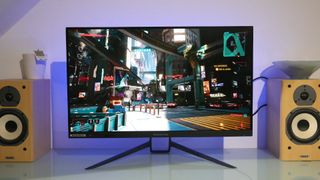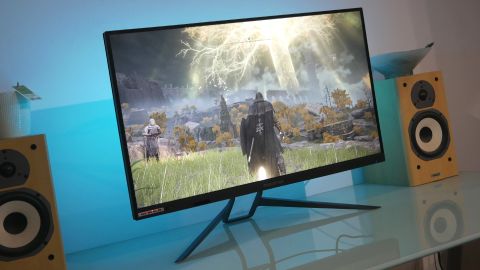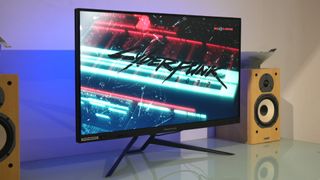Our Verdict
On paper, the Acer Predator XB3 XB323QK is everything we want in a gaming monitor. The 32-inch IPS 4K panel is absolutely stunning thanks to epic detail, slick 144Hz refresh, and good pixel response, while the connectivity on offer is truly comprehensive. So, it’s a pity the backlight is so restricted in SDR mode.
For
- Eye-popping 4K 144Hz experience
- Both HDMI and USB-C included
- Quick for an IPS monitor
Against
- SDR calibration needs a tweak
- Limited HDR support
- Pricier than we’d hoped
PC Gamer's got your back
Make no mistake, the Acer Predator XB3 XB323QK is one heck of a high-end gaming panel. We’re talking 32 inches, 4K, high refresh, IPS panel tech and comprehensive connectivity including HDMI 2.1. It’s all good.
There are bigger display options, to be sure. There are faster screens with higher refresh, wider aspect ratios and fancier display tech including mini-LED backlights and, latterly, even OLED panels. But where 27-inch 1440p has been the default option for discerning gamers for what feels like the last 10 years, this 32-inch 4K and (at least) 120Hz combo is increasingly likely to be the standard for the next decade.
You might immediately question that on account of the debilitating GPU load generated by any 4K monitor. For sure, you need a very high end GPU to make the most of the Acer Predator XB3’s 144Hz refresh. Pumping out eight million ray-traced pixels 144 per second is a terrifying computational task. However, it looks almost certain that the next generation of graphics cards from AMD and Nvidia will deliver in the order of double the performance of existing GPUs. If that happens, 4K is suddenly going to be a whole lot more relevant.
Anyway, Acer rates the XB3’s pixel response at 1ms GtG and 0.5ms MPRT, which is about as quick as IPS technology currently gets. The brightness rating of 400 nits is accompanied by VESA DisplayHDR 400 certification, although local dimming is notable for its absence. In other words, this isn’t a true HDR panel and is best viewed as a punchy SDR monitor. It’s not the last word in colour accuracy with claimed 90 percent coverage of the DCI-P3 digital cinema colour space. But as a gaming-centric panel rather than something aimed at content creation pros, that’s probably good enough.
Elsewhere, you get adaptive sync support, but no Nvidia G-Sync module, which is arguably no great loss. Connectivity includes DisplayPort 1.4 and a pair of HDMI 2.1 sockets, ensuring access to a minimum 120Hz refresh either way. You’ll need to use the DisplayPort 1.4 socket for the full 144Hz 4K. 240Hz is also available at 1080p if lower latency but at an interpolated resolution is your thing.
The HDMI connectivity also makes this the perfect tool for tag-teaming a PC with one of the latest 4K@120Hz-capable consoles. Acer has also included not only USB Type-C connectivity with power delivery but also a KVM switch. It really is comprehensive connectivity, albeit the USB Type-C interface is limited to 65 watts, which is fine for a thin-and-light laptop but is a little light for a true performance portable.
Oh, and if you care about this kind of thing, there’s configurable RGB LED lighting on the rear of the main chassis. Speaking of which, it's a slightly dated looking creature despite the slim bezels. Still, the lush metal stand is well-engineered and offers a full range of adjustments including height, tilt, swivel, and rotation.
But what of the really important bit, namely how this beast behaves? It’s not a zinger out of the box, that’s for sure. Running in default SDR mode, the maximum brightness is miles off the claimed 400 nits. It’s quite dull and disappointing, even with the backlight set to maximum.

To unlock some visual pop, you need to toggle HDR in the Windows display properties dialogue, and then crank up the SDR brightness setting. At which point, yup, this is much more like it. The colours really sizzle and there’s reasonable contrast for an IPS monitor albeit the factory calibration tends to crush details in brighter images. More to the point, the ability to increase the brightness further in conventional SDR mode would be preferable by far. Having to run HDR mode to get SDR content looking reasonably vibrant really is a bit kludgy.
If the general image quality has the odd quirk, the gaming experience is a more unambiguous win. For starters, this panel will be quick enough for all but the most demanding esports addicts. Yes, it is now hard to forget the incredible speed and sharpness of Alienware’s new and only slightly more expensive OLED monitor. But as IPS panels go, the Acer Predator XB3 is up there with the best. For the record, you get the option of two levels of pixel overdrive in the OSD menu. The quickest setting unleashes some obvious and ugly overshoot but ‘standard’ mode gives good, low-blur results.
Of course, the 144Hz refresh makes for fluid, low-latency gameplay provided you have a GPU that’s up to the job of driving all eight million pixels. Speaking of which, the sheer visual detail delivered by the native 4K res never gets old. Don’t let anyone tell you it’s not a significant step up from 1440p. It really is. And remember, those next-gen GPUs due later this year should make 100-plus fps in demanding games at 4K much more realistic.





As upscaling technology like Nvidia’s DLS and AMD’s FSR improve, that will only become more true. Once you’ve seen something like Cyberpunk 2077 running in all its ray-traced glory at 4K on a quality IPS panel, well, it’s hard to go back to 1440p, let alone 1080p. Notably, Alienware’s OLED panel offers nothing like the detail and pixel density on offer here.
All of which means the Acer Predator XB3 is tricky to rate overall. The slightly problematic SDR configuration is undeniably off-putting. That’s especially true given the XB3 occupies a pretty lofty price point. We were hoping this kind of monitor would slide in well under $1,000 (£1,000). But then so many products are expensive right now. And yet the gaming experience and overall feature set including USB Type-C connectivity is stellar. A minor firmware tweak is all it would take to make this a truly great monitor. Here’s hoping.
On paper, the Acer Predator XB3 XB323QK is everything we want in a gaming monitor. The 32-inch IPS 4K panel is absolutely stunning thanks to epic detail, slick 144Hz refresh, and good pixel response, while the connectivity on offer is truly comprehensive. So, it’s a pity the backlight is so restricted in SDR mode.

Jeremy has been writing about technology and PCs since the 90nm Netburst era (Google it!) and enjoys nothing more than a serious dissertation on the finer points of monitor input lag and overshoot followed by a forensic examination of advanced lithography. Or maybe he just likes machines that go “ping!” He also has a thing for tennis and cars.

Riot has been slowly chipping away at build creativity in League of Legends, all in the name of balance, but there are better solutions

Deus Ex director Warren Spector thinks that 'if someone made Deus Ex today it might be perceived as a documentary,' so if he made a new one it would be pretty different

Today's Wordle answer for Sunday, November 10

